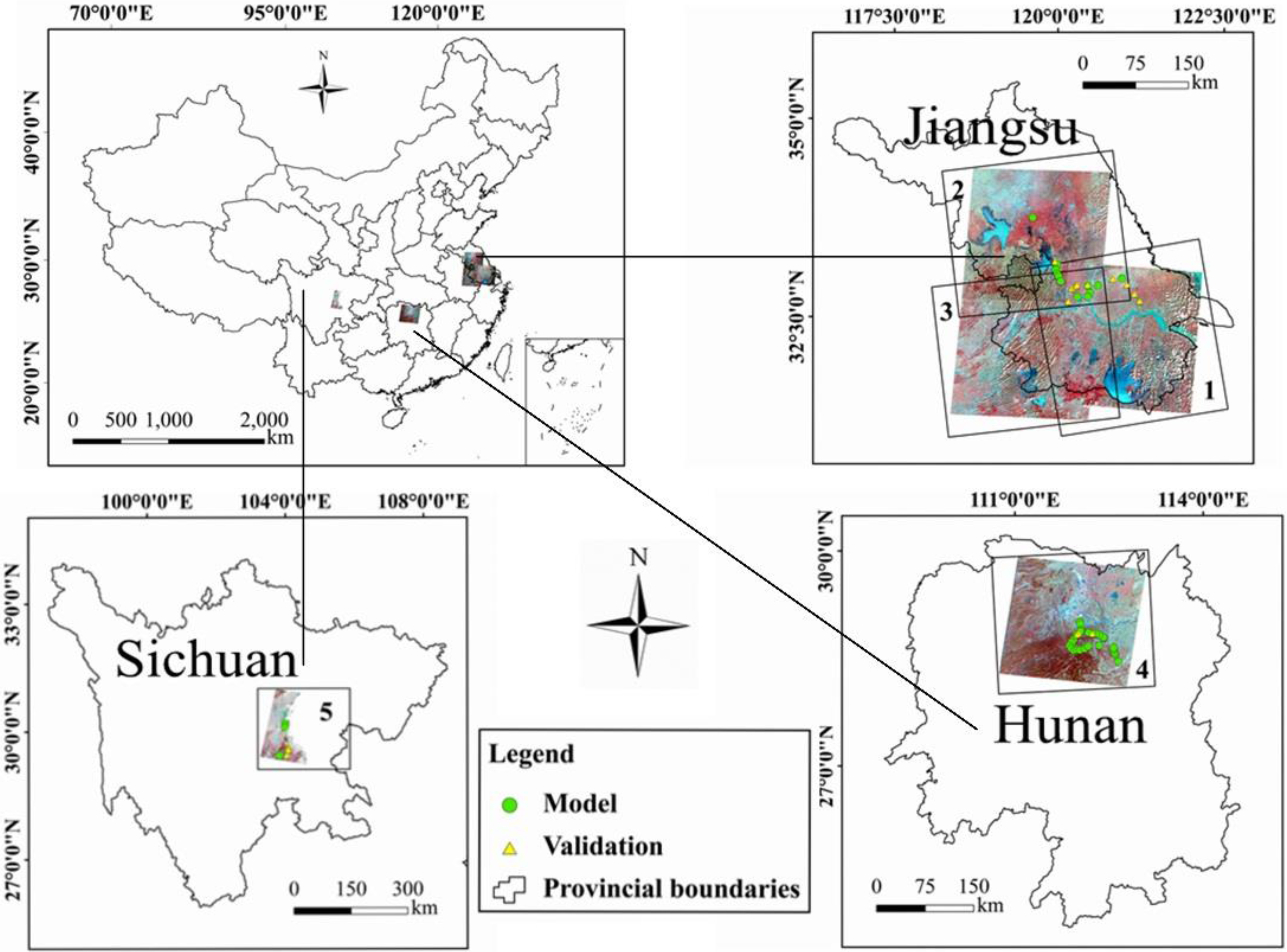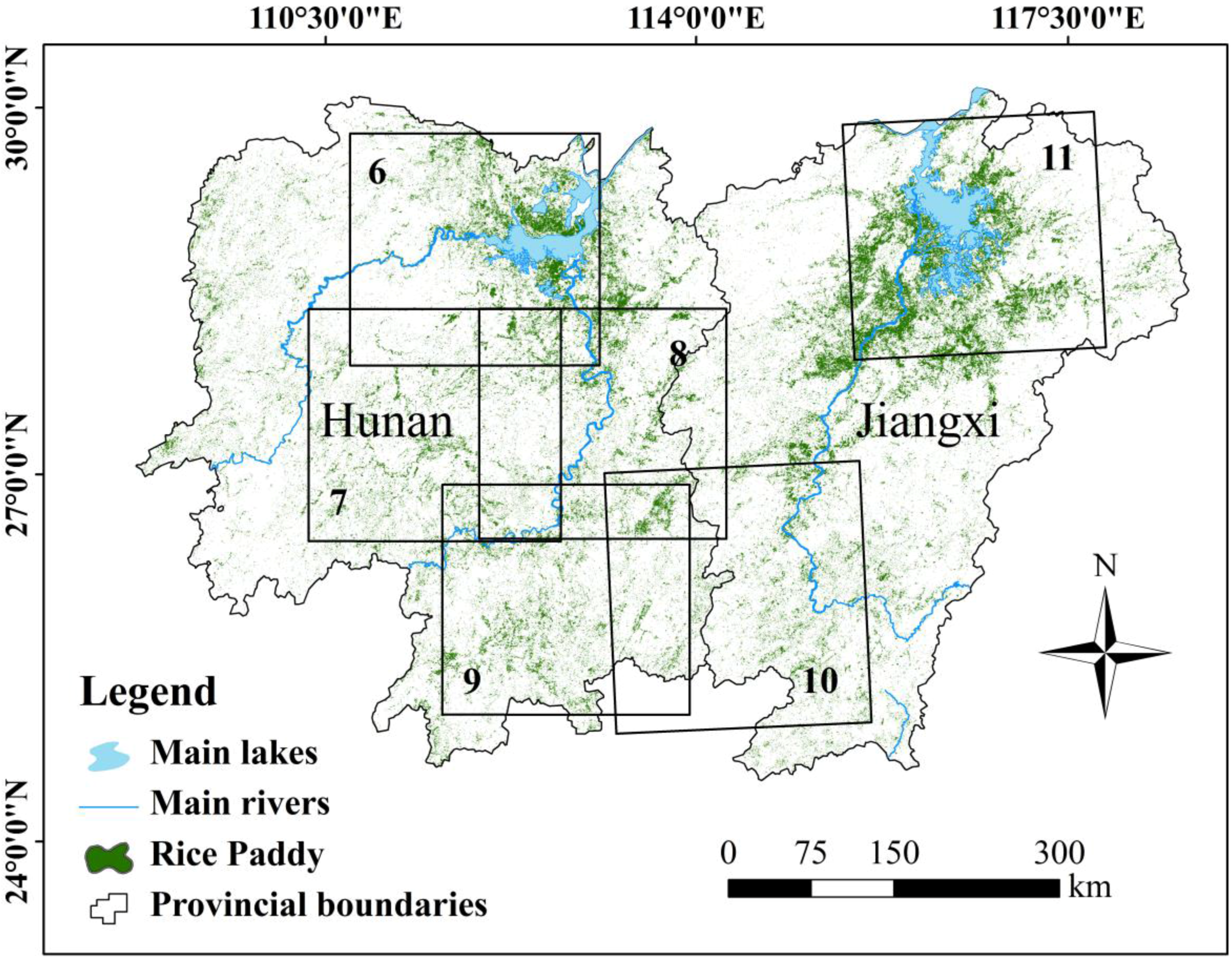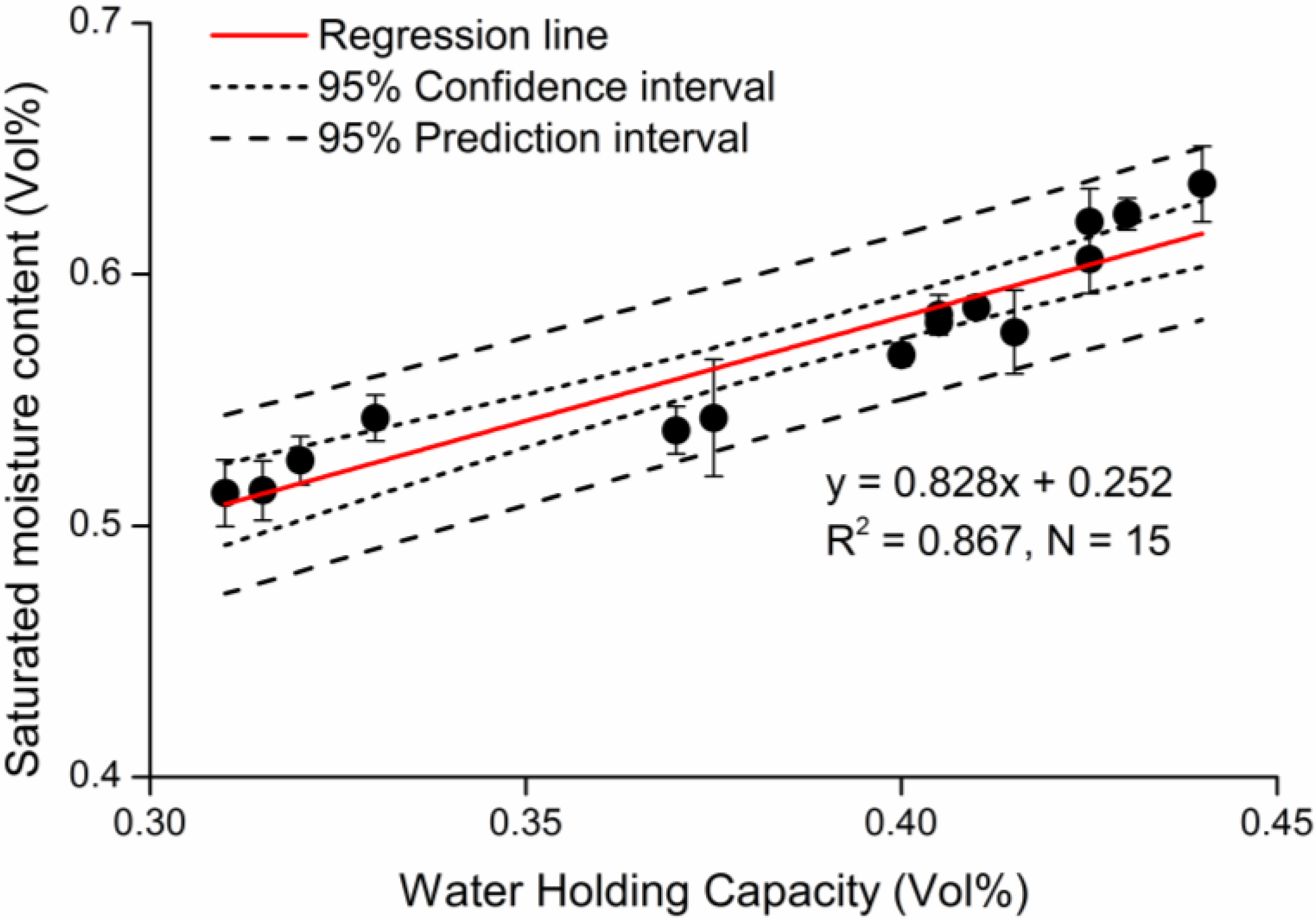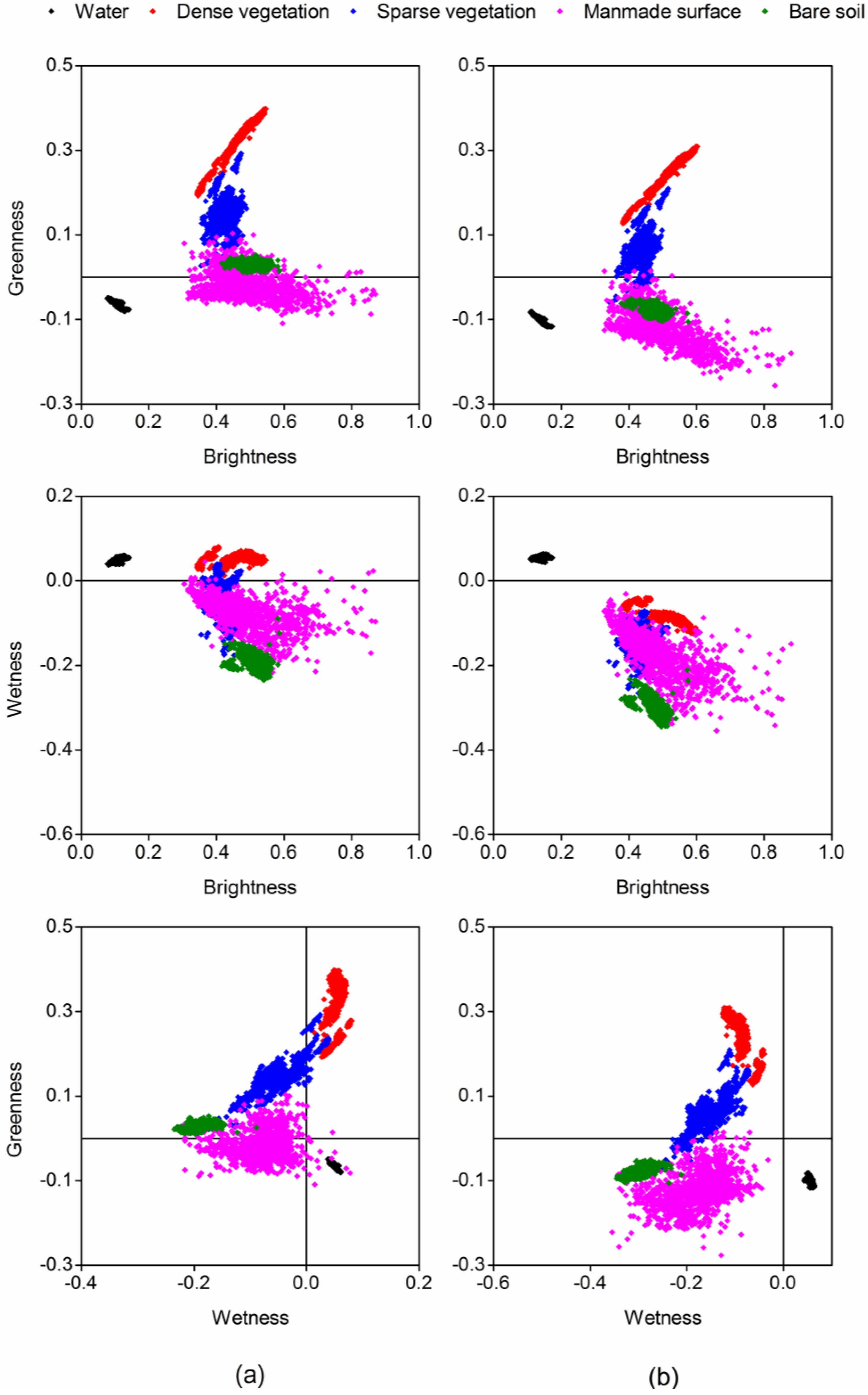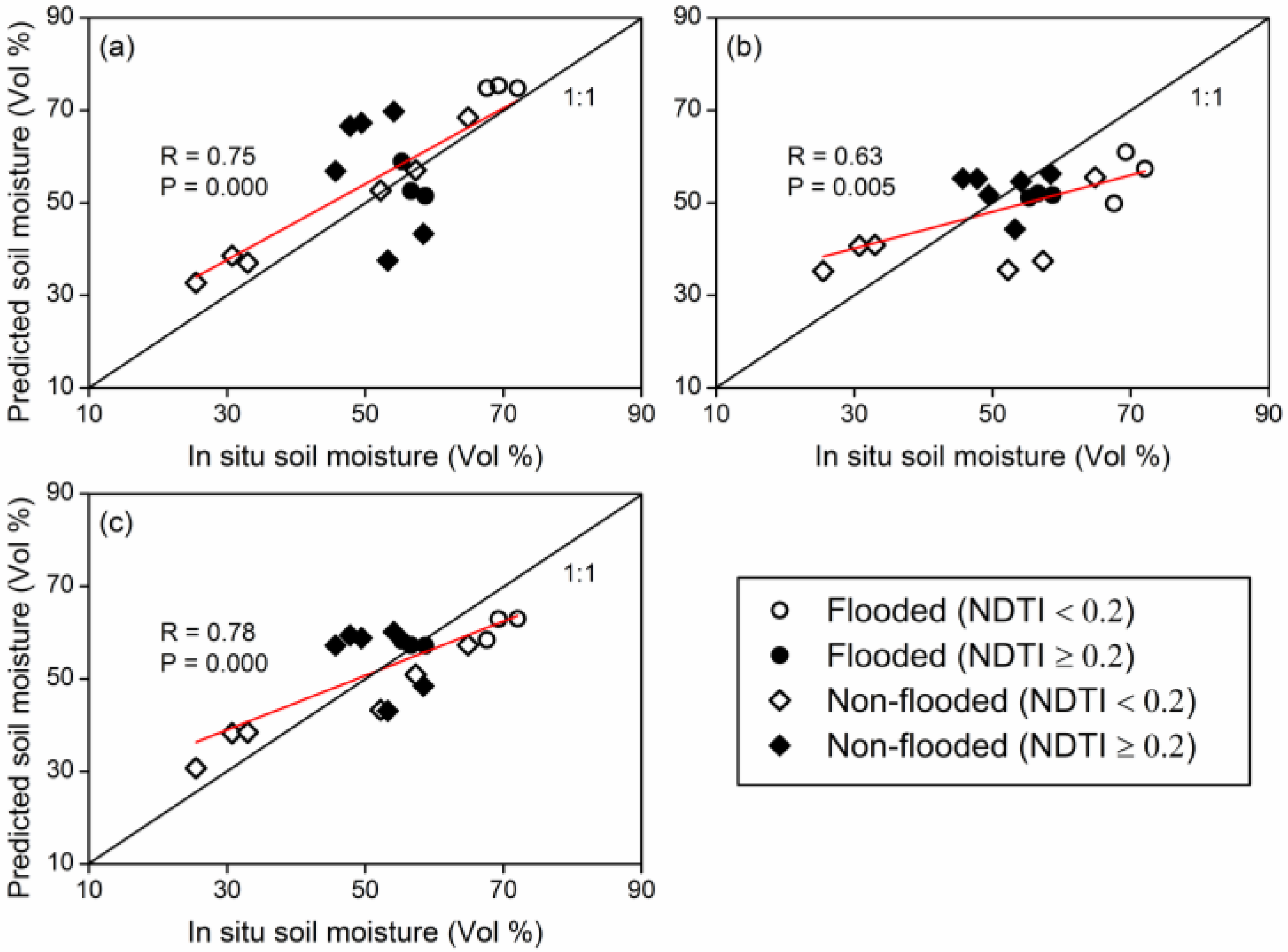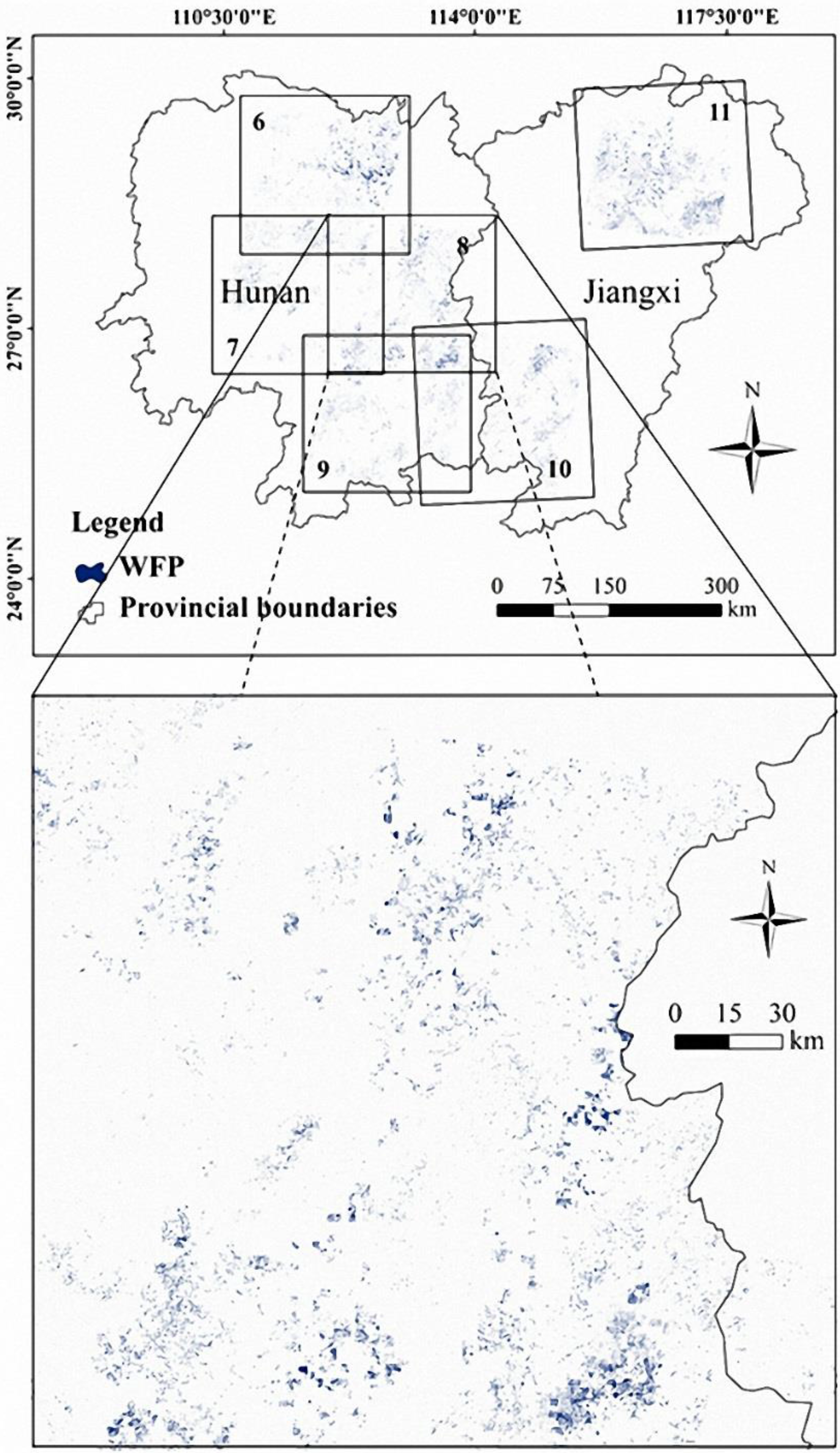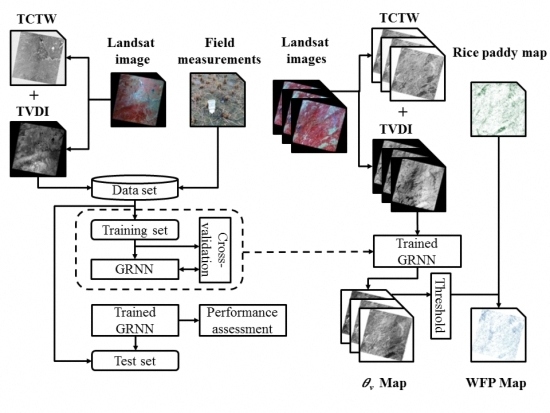3.2. Confirmation of Tasseled Cap Features
To confirm the tasseled cap features after transformation, nearly 7000 pseudo-invariant samples, including deep water, dense vegetation, sparse vegetation, manmade objects, and bare soil were selected randomly from the validation image (#10 image given in
Table 2).
The brightness, greenness and wetness axes are presented by the “tasseled cap” concept for the two transformations (
Figure 5). The shapes of the selected samples from the validation scene in the two sets of tasseled cap spaces are similar, whereas their orientation and relative location differ moderately from each other (
Figure 5). The greenness and wetness values of our transformation (hereafter referred to as ETM+-based TCT) were generally lower than those of Baig
et al. [
21] (hereafter referred to as TM-based TCT). In the brightness-greenness space, the greenness values of bare soil samples derived from the TM-based TCT are all greater than 0, and remain stable as the brightness value increases (
Figure 5a). On the contrary, the ETM+-based TC transformed space reveals that the greenness values of bare soil samples are all less than 0, and there is a slight decline in its greenness value as the brightness value rises (
Figure 5b). Considering that soil has the highest spectral reflectance in the short-wave infrared band (SWIR1, with a central wavelength of 1.609 μm) within the spectral range of Landsat 8 [
47], a smaller loading in the SWIR1 band may lead to lower greenness values of bare soil samples obtained after transformation, making it easier to discriminate bare soil pixels from sparse vegetation pixels using the greenness alone (
Figure 5). Larger disparities are found in brightness–wetness/wetness–greenness space. Besides deep water, the wetness value of dense vegetation as well as a few sparse vegetation and manmade objects samples derived from TM-based TCT are also greater than 0, which shows it is not possible to distinguish water pixels from dense vegetation pixels effectively by using wetness index only. It is suggested that the ETM+-based TC transformed space could better highlight the discrepancy between water bodies and other land cover types due to the wetness values of all land cover types derived from ETM+-based TCT being negative, except water pixels, and the wetness values increasing as the brightness values generally decrease. Taken together, the vegetation cover could be identified from the land surface using a threshold of Greenness index > 0, while the water body could be easily extracted from a TCTW image using a threshold of TCTW > 0. Therefore, it would be very efficient if the TCT-derived indices were introduced in a classification process.
Figure 5.
Comparison of tasseled cap spaces derived by (a) Baig et al. (2014) and (b) this study.
Figure 5.
Comparison of tasseled cap spaces derived by (a) Baig et al. (2014) and (b) this study.
3.3. Validation of Tasseled Cap Transformation
A total of 2667 pseudo-invariant samples, including dense vegetation, deep water and manmade surfaces, were selected randomly as an independent validation dataset. Mean bias error (MBE), mean absolute error (MAE), and root-mean-square error (RMSE) were used to assess the goodness of fit between the OLI-based TC value and the quasi real-time ETM+-based TC value from the two transformations.
where
n is the number of provinces, and E
i and O
i are the estimated and observed
θv, respectively. The MBE corresponds to the metrics of overestimation (−) and underestimation (+) [
48]. The method is perfect when MBE = 0, MAE = 0 and RMSE = 0.
The results achieved in terms of the three TC features are summarized in
Table 5. There appeared to be an obvious overestimation of the TM-based TCT greenness (MBE = 0.0588) and wetness values (MBE = 0.0739), though the correlation coefficients of both approaches were significant at the 0.01 level. Although the estimations of brightness from the two methods were comparable, better performance for greenness and wetness was achieved by our method; the
R2 increased by 0.0133 and 0.4428, the MAE decreased by 0.0312 and 0.0643, and the RMSE decreased by 0.0414 and 0.0811, respectively. Overall, it can be seen that the transform coefficients of this study can better maintain the tasseled cap features. The estimation accuracy, for the wetness index in particular, improved greatly.
There are several possible explanations for the improvement in our estimation. First, there is continuity between the band settings of Landsat 8 and Landsat 7, as well as some new spectral characteristics including the addition of a deep blue band, a shortwave-infrared band, and refinement of the spectral range of several bands corresponding to those of Landsat 7 ETM+ [
49]. These may bring estimation error if the TM TCT coefficients are directly applied to OLI data for creating the target feature space. Second, the DN-based TM TCT coefficients are suitable for raw DN images rather than radiometrically calibrated data. Therefore, an increase in the estimation error is likely when taking the at-satellite OLI images as input data. In addition, many studies have proven the effectiveness of at-satellite reflectance–based TCT coefficients [
25,
26]; however, the impacts of atmospheric scattering and sun illumination geometry still exist. The direct application of all samples to the images used to calculate the tasseled cap transformation coefficients may also lower the estimation accuracy. Our method has the capability to overcome the deficiencies mentioned above and can thereby obtain relatively accurate tasseled cap transformation indices.
Table 5.
Assessment of the two tasseled cap transformations.
Table 5.
Assessment of the two tasseled cap transformations.
| TCT | Index | R2 | MBE | MAE | RMSE |
|---|
| Baig et al. | Brightness | 0.9737 | 0.0132 | 0.0338 | 0.0432 |
| Greenness | 0.9807 | 0.0588 | 0.0588 | 0.0719 |
| Wetness | 0.5454 | 0.0739 | 0.0743 | 0.0947 |
| This study | Brightness | 0.9866 | 0.0432 | 0.0468 | 0.0567 |
| Greenness | 0.9940 | −0.0093 | 0.0276 | 0.0305 |
| Wetness | 0.9881 | 0.0010 | 0.0100 | 0.0136 |
3.4. Soil Moisture Content Retrieval
The relationship between the TCTW, TVDI and
θv could be complicated by the presence of various vegetated conditions in rice paddies during winter [
50]. The rice paddy may be partially or fully covered by rice straw, grass, or crop canopy (e.g., rape). This may have a negative effect on the
θv retrieval algorithm. It has been reported that the Normalized Difference Tillage Index (NDTI) is a good indicator for differentiating vegetation/crop residue from soil [
51,
52]. NDTI can be calculated by surface reflectance values from the two shortwave-infrared (SWIR) bands:
where
ρSWIR1 and
ρSWIR2 refer to the surface reflectance values from Band 5 and Band 7 in the Landsat-7 ETM+ sensor and Band 6 and Band 7 in the Landsat-8 OLI sensor, respectively. Therefore, as summarized from all the NDTI values at the
in situ field samples, the error statistics were calculated for two NDTI classes of <0.2 and ≥0.2. NDTI < 0.2 represented a low fractional crop residue/vegetation cover condition, whereas NDTI ≥ 0.2 indicated a moderate or high fractional crop residue/vegetation cover condition. Moreover, the ground water condition could also be a potential factor of influence for
θv estimation. Additionally, it is infeasible to separate the flooded or non-flooded status in paddies from different provinces using a fixed
θv threshold, because the saturated volumetric moisture content of paddy soil may differ in terms of variations in soil texture. Thus, we roughly classified the flooded or non-flooded status by visual interpretation. Taken together, during the non-rice growing period (usually from December to February), the rice paddy surface conditions can mainly be classified into four categories: (1) Flooded (NDTI < 0.2); (2) Flooded (NDTI ≥ 0.2); (3) Non-flooded (NDTI < 0.2); and (4) Non-flooded (NDTI ≥ 0.2).
The 64 field samples were randomly separated into training (46/64) and validation (18/64) samples. Different regressor combinations were inputted to the GRNN model in order to investigate the best performance for
θv retrieval. Assessing the accuracy was achieved by comparing the estimation results with the
in situ measured data in terms of different input configurations (
Figure 6). The error statistics (bias, MAE and RMSE) were calculated based on the validation dataset for different scenarios (
Table 6). The correlation coefficients of all the input configurations were significant at the 0.01 level. The TCTW+TVDI configuration gave the best performance as an input into the model, with the highest correlation coefficient (
R = 0.78,
P = 0.000) and lowest estimation errors (MAE = 7.19 and RMSE = 7.83). It seemed to be less effective in estimating
θv (for the retrieval process) using either the TCTW or TVDI configuration as the input into the model. The TVDI configuration yielded the largest estimation errors (MAE = 8.94 and RMSE = 10.39), with the lowest correlation coefficient (
R = 0.63,
P = 0.005). There was an underestimation of 3.69% in the TVDI configuration but an overestimation of 3.54% in the TCTW configuration. More specifically, the TCTW had a problem in estimating the process of
θv in non-flooded and vegetated areas, where considerably larger errors (MAE = 15.72, RMSE = 15.90) were produced compared to the samples with respect to other land cover types (
Table 6).
Figure 6.
Comparison between modeled and in situ measured volumetric surface soil moisture content (θv) with (a) TCTW; (b) TVDI and (c) TCTW+TVDI input configurations.
Figure 6.
Comparison between modeled and in situ measured volumetric surface soil moisture content (θv) with (a) TCTW; (b) TVDI and (c) TCTW+TVDI input configurations.
Table 6.
Assessment of the model performance under different scenarios.
Table 6.
Assessment of the model performance under different scenarios.
| | Vegetation Coverage Condition | Ground Water Condition | MBE (%) | MAE (%) | RMSE (%) |
|---|
| TCTW | NDTI ≥ 0.2 | Flooded | −2.53 | 4.96 | 5.20 |
| Non-flooded | 5.43 | 15.72 | 15.90 |
| NDTI < 0.2 | Flooded | 5.29 | 5.29 | 5.63 |
| Non-flooded | 3.80 | 3.89 | 4.88 |
| Pooled | Pooled | 3.54 | 8.25 | 10.13 |
| TVDI | NDTI ≥ 0.2 | Flooded | −5.25 | 5.25 | 5.39 |
| Non-flooded | 1.43 | 5.14 | 6.29 |
| NDTI < 0.2 | Flooded | −13.60 | 13.60 | 14.15 |
| Non-flooded | −3.07 | 12.24 | 13.02 |
| Pooled | Pooled | −3.69 | 8.94 | 10.39 |
| TCTW+TVDI | NDTI ≥ 0.2 | Flooded | 0.70 | 1.72 | 1.96 |
| Non-flooded | 3.05 | 9.78 | 9.96 |
| NDTI < 0.2 | Flooded | −8.20 | 8.20 | 8.30 |
| Non-flooded | −0.78 | 6.84 | 6.97 |
| Pooled | Pooled | −0.49 | 7.19 | 7.83 |
The presence of non-paddy rice vegetation, during the non-rice growing period, will increase the greenness signal and reduce the soil signatures as the canopies of green plants or straws partially or fully cover the paddy surface area [
53]. It has been suggested that the soil moisture status is the primary characteristic expressed in TCTW, while only a limited amount of plant moisture variation is represented in the tasseled cap space [
22]. As a consequence, the TCTW would work well on the condition that the land surface consisted of merely bare soil without any other materials. However, a much higher accuracy was achieved under flooded and vegetated surface conditions than under non-flooded and non-vegetated surface conditions. The cause of this may be that the water signature often dominates over the flooded rice paddy surface, as it is covered by a mixture of rice residue, soil and water bodies, and it then conceals the weakness of TCTW in estimating the soil moisture over vegetated areas. Most of the soil and vegetated surfaces are obscured under flooded conditions.
In contrast to the TCTW configuration, the TVDI configuration failed to estimate
θv over the bare soil areas, with the largest range of RMSE (13.02%–14.15%) (
Table 6), especially for the samples with a high moisture status (
θv > 50%) (
Figure 6). Furthermore, there was a high probability of
θv underestimation over flooded and bare soil areas (MBE = −13.60%). Mallick
et al. [
7] pointed out that the estimation results from an LST-VI index method like TVDI or SWI may be less reliable with low fractional vegetation cover because the wet edge is set as a horizontal base of the LST-VI triangle. Despite this, the same situation was observed in our experiment based on the parameters regressed from the sloping wet edge. Hence, we hypothesized that the definition of the wet edge was not a major concern affecting the prediction ability of TVDI. There are several likely causes for the considerably higher estimation error produced by the TVDI method. First, the differences in the optical-thermal infrared spectral bands and the performances of the instruments between Landsat 7 and Landsat 8 can give rise to slight variations in the derived Normalized Difference Vegetation Index (NDVI) and LST data used during the model training and prediction phase. Second, the non-linear stretching effect of NDVI can enhance the low-vegetation cover part within the full fractional vegetation cover range [
54], and the NDVI value over the bare soil area may be overestimated to some extent. Third, the land surface emissivity of the bare soil area was simplified to the soil emissivity as a substitution. This may lower the accuracy of the LST retrieval over the bare soil area. Because of this, the model parameters were not perfectly regressed, the prediction ability of TVDI decreased over the bare area. It can therefore be assumed that the combination of TCTW and TVDI can provide high sensitivity to changes in soil moisture over both sparsely and densely vegetated areas during the fallow period.
3.5. Extraction of the Winter Continuously Flooded Paddy
After the time series
θv images were collected using the TCTW+TVDI configuration modeling, we generated flooded paddy tiles for each
θv image with SMC thresholding over the case study area. Finally, the spatial distribution of WFP represented by the overlapping areas of flooded rice paddies of all three tiles in winter in Hunan and Jiangxi provinces was extracted based on the rice paddy map (
Figure 7). Winter flooded paddies were found to be sparsely distributed throughout the main rice planting areas of Hunan and Jiangxi provinces. The amount of WFP around the Dongting Lake and Poyang Lake regions was larger than in the other scenes probably due to the presence of significantly larger amounts of rice paddies. The ratio of the area of WFP to the total area of rice paddy under each Landsat scene coverage was then calculated and summarized in
Table 7. The average slope of the map of the case study area was used to classify the scene coverage into flat and hilly areas. The fraction of WFP in flat areas was comparable to that of hilly areas in Hunan, whereas there was an obvious increase in the fraction in flat areas than that of hilly areas in Jiangxi.
Figure 7.
Spatial distribution of WFP derived from 2013–2014 Landsat data in selected areas with a zoom of scene #8.
Figure 7.
Spatial distribution of WFP derived from 2013–2014 Landsat data in selected areas with a zoom of scene #8.
Table 7.
Fraction of WFP within Hunan and Jiangxi provinces.
Table 7.
Fraction of WFP within Hunan and Jiangxi provinces.
| Scene # | Path/Row | Geographic Location | Mean Slope (°) | Fraction of WFP (%) * |
|---|
| 6 | 124/40 | Hunan, China | 3.09 | 14.81 |
| 7 | 124/41 | Hunan, China | 4.71 | 13.74 |
| 8 | 123/41 | Hunan, China | 3.24 | 17.56 |
| 9 | 123/42 | Hunan, China | 5.00 | 15.80 |
| 10 | 122/42 | Jiangxi, China | 5.39 | 22.15 |
| 11 | 121/40 | Jiangxi, China | 2.65 | 15.06 |
Although Southwest China boasts a well-developed river system and relatively abundant water resources, the complex terrain and large fraction of mountainous areas always result in there being a long distance between the cropland and water sources, increasing the difficulty involved in water resource utilization. Most regions are unable to irrigate during the dry season because they do not possess the necessary water storage facilities, infrastructure and technology. Storing water in winter is an effective method for some areas to ease the pressure on water resource shortages in the rice growing period. However, long-term flooding is one of the main factors causing high CH
4 emissions during the rice growing period in southern China. The average CH
4 flux from a rice paddy that was flooded in the winter season (about 36.2 g·CH
4·m
−2) is approximately 1.9 times that from a rice paddy that experienced a drained winter season [
3,
4,
55]. Under these conditions, other rice varieties (e.g., water-saving and drought-resistant rice) and single rice–upland winter crop rotation could be effective options for mitigating CH
4 emissions without reducing grain yields under water-saving irrigation in the traditional WFP [
55,
56]. Therefore, the spatial distribution data of WFP could not only be useful for GHG emissions estimation, but also for guiding the selection of rice varieties and cropping patterns, as well as water resource management in local agricultural production. On the contrary, the plain areas have much better irrigation conditions, and thus there is no need to maintain WFP for supplementing water during the rice growing season.
However, corroboration of a continuous status of flooding remains difficult to fulfill at present. As an alternative solution, confusion matrices were calculated based on the ground-truth dataset to assess the accuracy of flooded paddy identification from the five single-date images in the study area (
Table 8). The 18 validation field sites mentioned in
Section 3.4, consisting of flooded (6/18) and non-flooded (12/18) samples, were used as the ground-truth dataset, and there was good agreement between the identification result and ground-truth data [
57]. Furthermore, we compared our estimate with the result from Yan
et al. [
58], who suggested 10% as the fractional amount of WFP in the CH
4 emissions of both Hunan and Jiangxi. Our results were 15.48% and 18.61%, for the fractional coverage of WFP in the total rice paddy area. This was evident in the case of the comparison between various modeled results and satellite observations, and regional discrepancies were subsequently found (e.g., Sichuan basin) [
59]. Moreover, the large dependence on the surface water status data in determining the CH
4 emissions has been exemplified in a report by Jonai and Takeuchi [
60]. Significant underestimation of the fraction of WFP may result in inconsistencies between modeled results and satellite observations. The validation of the WFP maps derived from remotely sensed data has a long way to go owing to a lack of census statistics. Further efforts should be made to create a validation database consisting of dynamic data collected from regional moisture monitoring networks and surveys from a considerable number of local people.
Table 8.
Assessment of the accuracy of flooded paddy identification.
Table 8.
Assessment of the accuracy of flooded paddy identification.
| Ground Truth (Pixels) | Flooded | Non-Flooded | Total |
|---|
| Flooded | 5 | 1 | 6 |
| Non-flooded | 2 | 10 | 12 |
| Total | 7 | 11 | 18 |
| Prod. Acc. (%) | 83.33 | 83.33 | |
| User Acc. (%) | 71.43 | 90.91 | |
| Overall accuracy (%) | 83.33 | | |
| Kappa coefficient | 0.64 | | |
